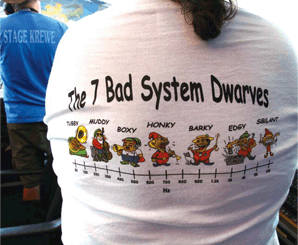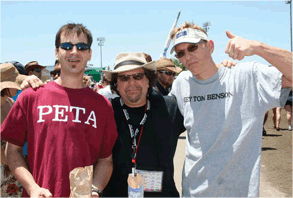Tom Bensen Builds Bigger Ideas As Audio Technology Becomes More Compact
Pictured from left to right at the 2008 New Orleans Jazz and Heritage Festival are Jason McCullar, head chef of Cure on Ferer Street; Tom Bensen, vice-president of RF Pro, which oversees the U.S. division of Powersoft; and Scotty Snodgrass, chef and co-owner of Restaurant One.
SCN: Your affection for pro audio began in your high school’s AV department. In college you were GM of campus radio stations and a founding board member of The City University Radio Network (CURN) in the early 1970s. How did your graduation into a career as radio announcer/ engineer spark your interest in the link between nascent computer technology and audio?
Tom Bensen: It was almost seamless, actually. While working as a broadcaster, I saw the advent of on-air automation systems using rudimentary microprocessors or simple computers controlling them. After leaving the broadcasting industry, I was employed at one time by an Austrian Audio/Photo company, EUMIG. We were connecting Commodore Pet 64K computers to our cassette recorders and operating them remotely. We actually began to penetrate the broadcasting market, automating several radio stations throughout the U.S. with this technology, back in the late ’70s. We were way ahead of the curve back then, even if the system was a bit clunky.
By the late 1980s, while representing Vega wireless, we introduced a computer-managed UHF wireless receiver. I think they were the first to marry the two technologies in the pro wireless arena. I remember a discussion 20 years ago with Gary Stanfill, Vega Wireless president at the time, where I said that I thought that in the not-too-distant future, computers (laptops) would be as commonplace on a production as a microphone.
SCN: You jumped into the live sound industry in 1980, working with beyerdynamic and later the RAMSA division of Panasonic, notably overseeing their involvement as the sound provider for the Los Angeles Olympic project in 1984. Next, you launched your own manufacturer’s rep firm, and later moved to Crest Audio, followed by XTA, co-founding PRAM Technologies with Henry Cohen along the way. Once again ahead of the technology curve with PRAM’s long-range wireless control solutions, what was your vision for burgeoning wireless technology?
TB: I had a very simplistic view of it, despite the complexity. Wireless represents freedom (or at least it did at one time—debatable these days with the FCC’s recent actions, which is another story!). Enjoying the convenience of wireless access in our homes—be that cordless telephones, remote controllers for multimedia, or wireless internet, not to mention our smart mobile phones—begets a certain level of convenience that creates a mindset.
For years and years now we have had wireless microphones and have seen this technology once remanded to the realm of the “black arts” in the early days, now become ubiquitous, almost to a fault. Professional productions simply require wireless these days. Performers and talent expect it. The need for production personnel to add wireless control to their toolbox was something we saw coming.
When Henry Cohen and I founded PRAM Technologies, we recognized the desire for wireless control technology would be on the rise. The freedom to walk around a venue and tune systems or monitors augmented the overall production quality and helped raise the bar.

Do any of these Seven Bad System Dwarves look familiar?
The wireless future belongs to those who can understand the impact of not only DTV and frequency re-allocation, but also the public demand for wireless access and bandwidth (White Space) and how that adversely affects our industry. So far with the new regulations, it’s not pretty, but the industry is paying attention.
SCN: In 2004, you founded RF Pro as the entity to manage Optocore Fiber and Trantec wireless. Along with your former employer at Crest, John Lee (who is now retired), you also formed the U.S. subsidiary of the Italian-based amplifier manufacturer, Powersoft. Does it seem like your mission in audio is continuing to bring digital technology to formerly analog realms?
TB: That’s certainly one take on it for sure, but it goes a bit further I would say. For whatever reason, it seems emerging technologies manage to come my way once in a while. That was certainly the case with companies like XTA, Optocore Fiber Optics, Lake, Trantec Wireless, Powersoft Amplifiers, and more recently, Outline Loudspeakers. The digital part, well, that’s inescapable these days. I think of all of it as an exercise in “volumetric efficiency”—getting more from less.
The need to be able to do more with a smaller package or footprint is an indisputable fact. Reduction of technology is paramount these days to lessening the impact in every aspect of our industry, be it live productions of all kinds or fixed installations. Saving energy, reducing transportation costs, and the overused but true “reduce the carbon footprint” mantra are commonly heard today. I prefer to look at my continuing mission in the years ahead as bringing green technologies to our industry, which raise the standard of quality, offer added convenience and in the long-run save money.
SCN: How would you complete the following statements?
You know you’re a true audio nut when... you think the food at the audio conventions is gourmet quality. If it doesn’t sound good... ask the person next to you. If they think its okay, then one of you is wrong.










